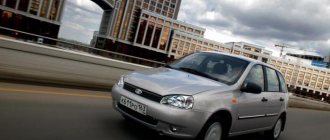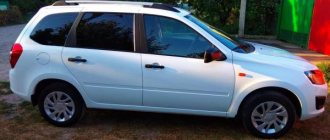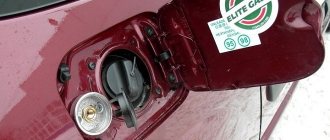Those. characteristics
Lada (VAZ) 2170 (Priora) (2007(2013)) 2013 – present gg.
| Brand and modification | Body type | Volume | Power | Release |
| Lada (VAZ) 21703 (Priora) | sedan (4 doors) | 1596 cm3 | 98 hp | 03.2013 – present |
| Lada (VAZ) 21703 (Priora) | sedan (4 doors) | 1596 cm3 | 106 hp | 03.2013 – present |
| Lada (VAZ) 21713 (Priora) | station wagon (5 doors) | 1596 cm3 | 98 hp | 2013 – present |
| Lada (VAZ) 21713 (Priora) | station wagon (5 doors) | 1596 cm3 | 106 hp | 2013 – present |
| Lada (VAZ) 21723 (Priora) | hatchback (5 doors) | 1596 cm3 | 98 hp | 2013 – present |
| Lada (VAZ) 21723 (Priora) | hatchback (5 doors) | 1596 cm3 | 106 hp | 2013 – present |
| Lada (VAZ) 21728 (Priora) | hatchback (3 doors) | 1596 cm3 | 98 hp | 2013 – present |
| Lada (VAZ) 21728 (Priora) | hatchback (3 doors) | 1596 cm3 | 106 hp | 2013 – present |
Lada (VAZ) 2170 (Priora) (2007) 2007 – 2013
| Brand and modification | Body type | Volume | Power | Release |
| Lada (VAZ) 21701 (Priora) | sedan (4 doors) | 1596 cm3 | 81 hp | 04.2007 – 2013 |
| Lada (VAZ) 21702 (Priora) | sedan (4 doors) | 1596 cm3 | 89 hp | 03.2007 – 2013 |
| Lada (VAZ) 21703 (Priora) | sedan (4 doors) | 1596 cm3 | 98 hp | 04.2007 – 2013 |
| Lada (VAZ) 21713 (Priora) | station wagon (5 doors) | 1596 cm3 | 98 hp | 05.2009 – 2013 |
| Lada (VAZ) 21721 (Priora) | hatchback (5 doors) | 1596 cm3 | 81 hp | 02.2008 – 2013 |
| Lada (VAZ) 21722 (Priora) | hatchback (5 doors) | 1596 cm3 | 89 hp | 05.2009 – 2013 |
| Lada (VAZ) 21723 (Priora) | hatchback (5 doors) | 1596 cm3 | 98 hp | 02.2008 – 2013 |
| Lada (VAZ) 21728 (Priora) | hatchback (3 doors) | 1596 cm3 | 98 hp | 01.2010 – 2013 |
View technical characteristics of other Lada (VAZ) / Lada (VAZ) models
The automobile catalog contains descriptions, technical characteristics and photographs of Lada (VAZ) 2170 (Priora) / Lada (VAZ) 2170 (Priora) cars produced since 1997.
Modifications of Lada Priora
Lada Priora 1.6 AMT
| Maximum speed, km/h | 183 |
| Acceleration time to 100 km/h, sec | 11.4 |
| Engine | Petrol |
| Working volume, cm3 | 1596 |
| Power, hp / rpm | 106/5800 |
| Torque, Nm/rpm | 148/4200 |
| Combi consumption, l per 100 km | 6.6 |
| Gearbox type | Robotic, 5 gears |
| Drive unit | Front |
| Show all characteristics | |
Lada Priora 1.6 MT
| Maximum speed, km/h | 176 |
| Acceleration time to 100 km/h, sec | 12.5 |
| Engine | Petrol |
| Working volume, cm3 | 1596 |
| Power, hp / rpm | 87/5100 |
| Torque, Nm/rpm | 140/3800 |
| Combi consumption, l per 100 km | 7.0 |
| Gearbox type | Mechanical, 5 gears |
| Drive unit | Front |
| Show all characteristics | |
Lada Priora 1.6 MT 106 hp
| Maximum speed, km/h | 183 |
| Acceleration time to 100 km/h, sec | 11.5 |
| Engine | Petrol |
| Working volume, cm3 | 1596 |
| Power, hp / rpm | 106/5800 |
| Torque, Nm/rpm | 148/4200 |
| Combi consumption, l per 100 km | 6.9 |
| Gearbox type | Mechanical, 5 gears |
| Drive unit | Front |
| Show all characteristics | |
Lada Priora 1.6 MT 98 hp
| Maximum speed, km/h | 183 |
| Acceleration time to 100 km/h, sec | 11.5 |
| Engine | Petrol |
| Working volume, cm3 | 1596 |
| Power, hp / rpm | 98/5600 |
| Torque, Nm/rpm | 145/4000 |
| Combi consumption, l per 100 km | 6.9 |
| Gearbox type | Mechanical, 5 gears |
| Drive unit | Front |
| Show all characteristics | |
Technical characteristics of Lada Priora sedan 1.6 liter 8v 5-speed manual transmission
| Motor power | 80 hp |
| Torque | 120 Nm |
| Acceleration to 100 km/h | 12.5 s |
| Max. speed | 172 km/h |
| Fuel type | AI-95 |
| Consumption in the city | 9.8 l |
| Highway consumption | 5.8 l |
| Mixed flow | 7.6 l |
| Volume of the tank | 43 l |
| Trunk volume | 430 l |
Disadvantages, breakdowns and problems of Lada Priora 2170
Body
The body's resistance to corrosion is weak; rust can already be found on two-year-old cars. The paintwork is thin, chips form quickly and literally immediately turn yellow.
Salon
The interior begins to squeak from the first kilometers and over time the squeaks only intensify. There is no sound insulation here, the front seats are uncomfortable, and the back is quite cramped.
But the main headache is the electrics. Anything breaks here, anytime. Moreover, repairs do not guarantee that the same thing will not fail again the next day.
Engine
There were four 1.6-liter power units, but their main problems were generally similar:
- failure of sensors, and on new engines and electronic throttle
- breakage of the timing belt due to old age, a wedge of one of its rollers or a water pump
- sticking of the thermostat, followed by engine overheating and gasket breakdown
- oil leaks causing it to get into the spark plug wells and fogging of the ventilation breather
Transmission
The original mechanics of the VAZ 2170 are essentially a slightly strengthened version of the Lada 110 gearbox and are famous for unclear switching, release noise and weak synchronizers.
The new manual transmission VAZ 2180 with cable drive is more reliable and more pleasant to use. The VAZ 2182 robot has received mixed reviews, read about it in a separate article.
Suspension
The suspension is the car's strong point and is ideal for our roads. Reliability is quite good; the first things to be replaced here are steering ends and wheel bearings. Next, the ball joints and support bearings of the struts fail, but they are inexpensive.
The brakes are quite normal, but the original pads need to be replaced as soon as possible. The first years of production there were a lot of problems with a defective electric power steering.
Facelift
On the training ground we looked like children looking for differences in two seemingly identical pictures. So, looking back at the pre-restyling car, which we immediately dubbed old, we begin to bend our fingers, counting the updates. The front bumper, which appeared on the model last year, has not changed, so at first glance both Prioras appear the same.
The only difference is the plastic radiator grille - the new honeycomb structure has refreshed the exterior. Although at a distance the honeycombs still need to be seen. The headlights are the same. I agree with the opinions of the owners on numerous forums: they work as they should.
In the stern, the main focus is on the lights. Now in their lower part there are LEDs, which are longer lasting than ordinary lamps that are on a white car. Larger reflectors on the bumper also help to outline the dimensions. At dusk, the new lighting technology really showed itself better - it was noticeably brighter.
Specifications
Below we will talk about each element of the Lada Priora separately, namely, we will consider separately the body, engine, trunk, etc.
Body
Priora was produced in several bodies. In 2007, only a sedan appeared; later, in 2008, the first hatchback and station wagon rolled off the assembly line.
Sedan 2170
This body turned out to be very nice and most popular among young people. Young people started buying Priora and subjecting it to various tunings. It became a kind of youth movement.
Station wagon 2171
This type of body is an excellent solution for family people. The station wagon is equipped with a huge trunk.
Hatchback 2172
The hatchback does not differ from the sedan in technical characteristics and the front part of the body, but is shorter by several centimeters, which is noticeable to the naked eye.
Engine
Several types of engines with different power and number of valves were installed on the Lada. The table below shows all installed engines and their characteristics.
| Model | 21126 | 21127 | 21116 |
| Number of valves | 16 | 16 | 8 |
| Power (hp) | 98 | 106 | 87 |
| Type | Petrol | Petrol | Petrol |
| Torque, Nm / rpm | 145/4000 | 148/4200 | 140/3800 |
| Number of cylinders | 4 | 4 | 4 |
| Cylinder arrangement | Row | Row | Row |
| Volume (cubic cm) | 1596 | 1596 | 1596 |
| Fuel | Gasoline AI 95 | Gasoline AI 95 | Gasoline AI 95 |
| Power type | Electronic injection | Electronic injection | Electronic injection |
| Maximum speed, km/h | 183 | 183 | 172 |
| Acceleration time to 100 km/h | 11,5 | 11,0 | 12,5 |
| Average fuel consumption per 100 km | 7,2 | 7,2 | 7,6 |
Gear box
Priora was equipped with several gearboxes depending on the configuration and year of manufacture of the car. All gearboxes are 5-speed
Gearbox with rocker
This gearbox was installed on cars from 2007 to 2013. It is a fairly reliable and unpretentious gearbox, its main “soreness” is the weak second gear, which begins to fly out over time.
Cable gearbox
Installed on cars since 2014. Received a large number of positive reviews, the position of the gears, namely the reverse gear, has changed. The vibrations transmitted to the cabin from the gearbox have been reduced.
Robotic gearbox
In 2014, luxury car models began to be equipped with a robotic gearbox. It is very reliable and unpretentious, but noticeably loses in dynamics compared to a manual transmission.
Other characteristics
| Characteristic | Sedan | Station wagon | Hatchback |
| Height, mm | 1420 | 1435 | 1508 |
| Width, mm | 1680 | 1680 | 1680 |
| Length, mm | 4350 | 4340 | 4210 |
| Wheelbase, mm | 2492 | 2492 | 2492 |
| Weight, kg | 1163 | 1163 | 1088 |
| Number of seats | 5 | 5 | 5 |
| Number of doors | 5 | 5 | 5 |
| Drive unit | front | front | front |
| Wheels | 185/65 R14 | 185/65 R14 | 185/65 R14 |
| Tank capacity, l | 43 | 43 | 43 |
| Trunk volume, l | 430 | 444/777 (with rear seats folded) | 360/705 (with rear seats folded) |
Safety
In the “Norma” configuration, the car is equipped with a driver’s airbag. The car body is strengthened to improve passive safety. The torsional rigidity of the body has also increased. Since May 2008, the Lada Priora car has been produced in the “Lux” configuration, which includes a front passenger airbag, ABS and a safe parking system. As a result of a crash test conducted by Autoreview [2] according to the EuroNCAP standard, the Lada Priora received 10.56 points out of 16 possible.
How much does Lada Priora weigh?
The weight of the car before restyling in 2013 was as follows:
- The 3-door hatchback coupe, 5-door hatchback and sedan have a curb weight (which includes the weight of a full tank of fuel and the driver) of 1088 kg. In this case, the total weight (i.e., the maximum permissible weight of the vehicle at which it can be operated after being fully loaded) is 1578 kg;
- The station wagon, with the same curb weight, is able to take a little more cargo, and its total weight reaches 1593 kg.
Thus, the station wagon is the most load-carrying of all Priora body types.
Body
In all versions of the Priora, the bodywork is mediocre. Drivers and experts had 2 complaints:
Susceptibility to rust. The body is made of ordinary steel, without alloying additives. For this reason, after the first winter it begins to actively rust and it will not be possible to stop this process.
Poor paintwork. Some noticed that it began to fall off in large “chips.” You will have to constantly visit the paint shop to paint over them, otherwise the corrosion process will be unstoppable.
Cargo capacity
Cargo capacity (not payload!) of the Prior varies depending on the body type. So, trunks have different volumes:
- 360 liters – for hatchback and coupe;
- 430 liters - for the sedan;
- 444 liters - for the station wagon.
As we can see, this volume is not very different from the sedan’s, so it’s a very stretch to say that the Priora station wagon was created to solve a wide range of economic problems (relative to other variants of this car). Of course, cargo capacity increases significantly if you fold the back of the rear sofa, or even better, remove the entire rear seat.
Anti-aging treatments
As soon as you start the engine, the new car’s low beam headlights flash, even if the switch is in the “0” position - convenient. The indicator squeaks to warn you that your seat belt is not fastened, and when you lightly touch the steering column, the turn signal flashes three times.
I turn on the side lights sequentially, then the headlights... Not one icon appears on the instrument panel, like in an old car, but two. It’s a small thing, but now you don’t have to guess what lighting equipment works.
The new instrument panel is more interesting in terms of design. In general, there were no special complaints about the previous one, but it was too simple and had already become familiar. And then there were the wide white arrows and well-arranged pictograms, and I immediately fell in love with the new product.
The updated dashboard not only refreshed the interior, but also added convenience. The on-board computer screen was placed in the center. There is no unnecessary beauty on the monitor, everything is simple, but large numbers are clearly visible in motion.
The driver's position is praised by many owners, but being 190 cm tall, I feel uncomfortable in the seat: there is very little space in the area of the pedal assembly of the old car, and there is not enough longitudinal adjustment of the seat. The updates have corrected the situation a little: the seat slides in the new car have been lengthened, so you don’t have to lean the back too much back.
The chair is denser, it better fixes the body in turns. The distance between the gas and brake pedals is noticeably greater. Having adjusted the driver's seats in both cars, I tried to sit back and couldn't. The backs were too close to the rear sofas. And if four people get into the car, I, the driver, will have to press my knees to my ears.
Dimensions of VAZ 2170 and other modifications of Priora
The dimensions of the car are something that needs to be taken into account when purchasing, since the dimensions of parking spaces, garages, turns or entrance arches are not always universal. The height is measured from the extreme point of the front to the extreme point of the rear bumper. The width is measured at the widest point, and the height is measured from the surface of the ground to the highest point of the roof. Roof rails and racks do not fit into the height of the body. Taking this into account, the dimensions of the Priora are as follows:
- The longest body of cars in this family is the sedan. It measures 4350 mm in length. But at the same time it is the lowest - 1420 mm. in height.
- The next longest is the station wagon, with its 4340 mm length. It is the highest in height – 1508 mm.
- The five-door hatchback and three-door coupe are the shortest - 4210 mm. at 1435 mm. in height.
In all four cases, the width of the Priora is the same - 1680 mm. Ground clearance is 165 mm, although in the Priora Sport configuration it is somewhat reduced, but this is no longer so important, since this car is no longer produced in this version.
Let's sum it up
Modern cars are not the privilege of the AvtoVAZ concern, at least until today. But the company is striving to change its status and gain greater recognition in its state and beyond. Today, buying a new Lada is no longer as unusual as it used to be. The company began promoting its new models, which turned out to be of quite high quality, durable, and interesting in appearance. The cars have a good character, which allows them to take first place in sales in their class without much difficulty.
Despite the fact that many buyers are dissatisfied with Lada's pricing policy, the concern continues to develop and maintain a leading position in sales in certain segments. Today, the manufacturer’s products are even supplied to Central European countries and are beginning their promotion in this difficult market. But Lada Priora will no longer be a participant in this banquet. Most likely, the company is minimizing its model range in order to expand it into new segments and create more constructive competition in the market. What do you think about the removal of one of the most popular VAZ models from the assembly line?











